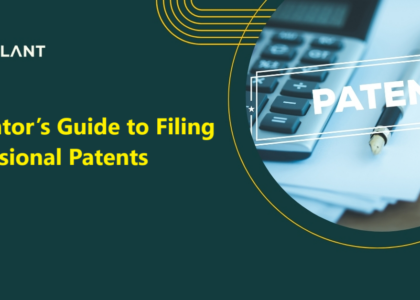

Drafting A Provisional Patent Application
A provisional patent application is a legal document that permits an inventor to file a patent application without submitting a full patent application. Provisional patent applications give the filer a year to see if their idea will be profitable enough to warrant obtaining a patent on their intellectual property. A patent might restrict the size, design, or impression of an invention to the inventor alone.
What should a provisional patent application include?
Let’s look at several disclosures that can help a provisional patent application stand out.
- Discuss the problem you solved: All of your ideas originate from a problem, concern, or issue you were attempting to resolve. While a description of the problem is not required for obtaining a patent, it typically aids in the development of the solution description.
- Identify features that make your concept unique: Assuming that existing products (also known as “prior art”) are insufficient to solve the problem, identify the additional features that distinguish your concept.
- Be broad and narrow in describing each new feature: A strong provisional covers all of your invention’s major features in both breadth and depth. Let’s imagine you have a concept for a consumer product that includes new features X and Y. You should go into great depth about each aspect. Discuss each structure, dimension, and its relationship to other components, as well as what it does and doesn’t do, what it includes and excludes, and so on. Don’t be concerned if your description is overly restrictive; the claims, not the description, will determine the scope of your patent rights. Simultaneously, you can state that characteristics X and Y are not restricted to the specific examples or embodiments displayed and described. Consider how different structures and systems could achieve the same result.
- Ask yourself tough questions: The Patent Office is increasingly rejecting utility patent applications on the grounds of obviousness, which means that it would have been obvious to a person of ordinary ability in the art to combine/add/delete/modify a prior art product to arrive at your claimed innovation. As a result, you can enhance your provisional by highlighting reasons why coming up with your idea would not be evident (e.g., folks have always been doing things a certain way and would not think to do it my way because . . ., etc.). You can talk about roadblocks, obstacles, and other non-obvious considerations that can drive others to avoid your solutions.
- Plan ahead for the nonprovisional application: Make a note of the one-year deadline for filing a nonprovisional patent application as well as any overseas patent applications. Our firm not only schedules this date in our docketing system for our clients but also sends out regular email reminders well in advance of the deadline. You should plan on deciding at least three months before the 1st anniversary of the provisional filing date to allow your patent attorney enough time. So, take advantage of the months after the provisional filing to ensure that you have enough funds to proceed with the nonprovisional. If you’ve developed additional features or improvements that weren’t included in your provisional when it was filed, you should file a subsequent provisional or a nonprovisional as soon as possible to get the earliest feasible filing date for the new subject matter.
How to File a Provisional Patent Application?
A provisional patent application is an important initial step in safeguarding an inventor’s intellectual property. This is significant because, without a patent, some characteristics of a product, such as its size, design, or expression, are open to others to use and benefit from. Intellectual property lawyers can help with provisional patent applications and are familiar with the filing process.
A simple six-step approach is the simplest way to file a provisional patent application:
Step One: Research Your Invention
Verifying the exclusivity of your innovation is the first step in filing a provisional patent application. A provisional patent application may be a waste of time if someone else has previously come up with an identical idea or if the idea is too obvious. Before moving on, make sure you do your study to ensure that your invention is novel and distinctive.
A patent search is an excellent technique to ensure that your innovation meets the standards for a provisional patent application. This can be done through the USPTO or the World Intellectual Property Organization (WIPO) websites, where you can do a claims patent search using a variety of keywords to accurately vet your innovation.
Step Two: Gather Patent Information
A provisional patent application should contain a lot of product-specific information about the product you want to patent. You’ll need to gather as much information on your product as possible to prepare for the next phases. Here are some bits of data you’ll need to gather and organize:
- Specifications
- Drawings
- Abstract
- Invention status
- Intended use
Step Three: Write a Coversheet
Any provisional patent application must include a cover sheet. Each application must contain a cover sheet that includes the following information:
- Names of all involved inventors
- Inventors’ addresses
- Name of invention
- Name and credentials for attorney or agent and any applicable docket numbers
- Correspondence address
- If a government agency has an interest in an invention, that must be disclosed here
Step Four: Prepare a Product Description
Another crucial component of a provisional patent application is a detailed product description. Make sure to include details such as the product’s dimensions in your specifications. This section of the application should also include any shop drawings, abstracts, or schematics. Make sure to include all relevant product details in the product description, which should be as precise as possible.
Step Five: Review and Edit
Review your application carefully, paying specific attention to any spelling or grammatical problems. This is also a good opportunity to go through any notes or outlines you used to construct your application and double-check that the provisional patent application has all of the information you have about your product.
Step Six: Submit Application
When submitting a provisional patent application to the USPTO, make sure you have the resources to file a formal patent application within 12 months after the provisional application’s submission. It’s important to remember that provisional patent applications cannot be renewed or extended, thus timing is crucial. You should expect to pay anywhere from $65 to $280 in filing fees when applying. After you’ve submitted your application, you can start selling, marketing, and even further developing your idea right away. Digitally, by facsimile or email, in person, or by mail, applications can be submitted.








